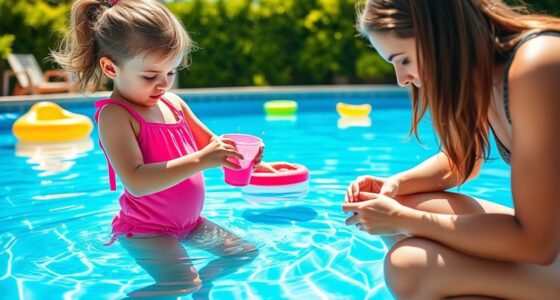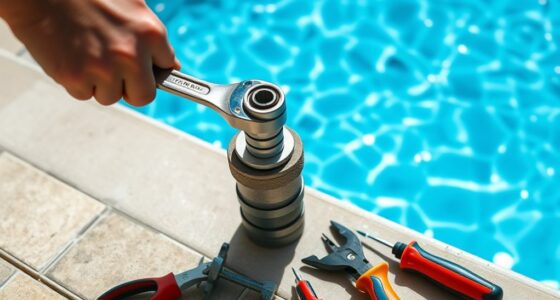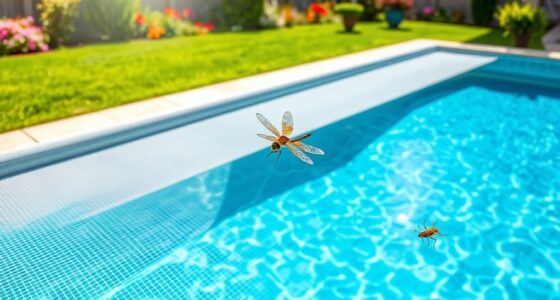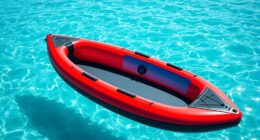To save water and reduce pool waste, always cover your pool when it’s not in use to prevent evaporation. Maintain proper water levels and fix leaks immediately to avoid unnecessary loss. Use pool covers and schedule regular maintenance to keep equipment running efficiently. Opt for water-conserving equipment and consider smart systems to monitor usage. Following these tips helps conserve water and extend your pool’s lifespan—continue along to discover more effective strategies.
Key Takeaways
- Use a pool cover consistently to minimize evaporation and maintain water temperature.
- Fix leaks promptly to prevent continuous water loss and ensure efficient pool operation.
- Regularly adjust pump and filtration schedules to reduce unnecessary water and energy use.
- Maintain proper water levels to prevent overfilling and reduce evaporation.
- Conduct routine maintenance and debris removal to lower water and chemical replacement needs.
Regularly Cover Your Pool to Minimize Evaporation
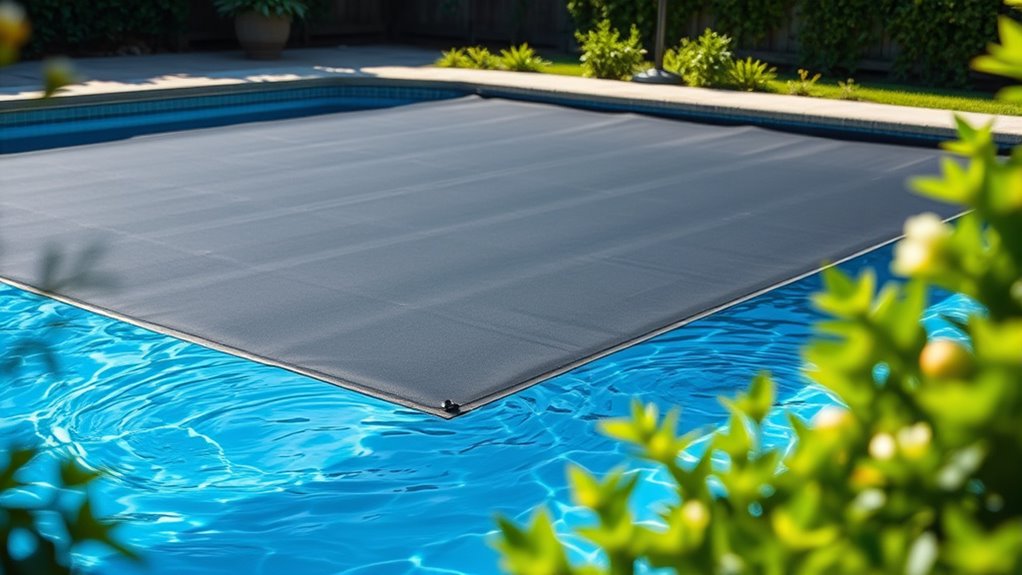
Covering your pool regularly is one of the easiest ways to reduce water loss from evaporation. Pool cover benefits are considerable, especially for evaporation control. When you use a cover, it creates a barrier that minimizes the water exposed to the air, notably reducing evaporation during hot or windy days. A good pool cover helps maintain water temperature, lowering the need to add extra water for heating purposes. It also protects your pool from debris, which can cause additional water loss from cleaning requirements. By consistently covering your pool when it’s not in use, you ensure less water escapes into the environment, saving both water and energy. Using a pool cover not only conserves water but also extends the lifespan of your pool equipment by reducing strain. Proper installation and maintenance are essential to maximize the benefits of your pool cover and ensure it remains effective over time. Additionally, understanding evaporation rates can help you choose the right cover type and improve your water conservation efforts. Employing water-saving techniques can further optimize your pool’s efficiency and reduce overall consumption. Recognizing these preventive measures can lead to more effective water conservation in the long run. This simple step makes a noticeable difference in conserving water and keeping your pool maintenance easier and more cost-effective.
Maintain Proper Water Levels to Prevent Excess Loss
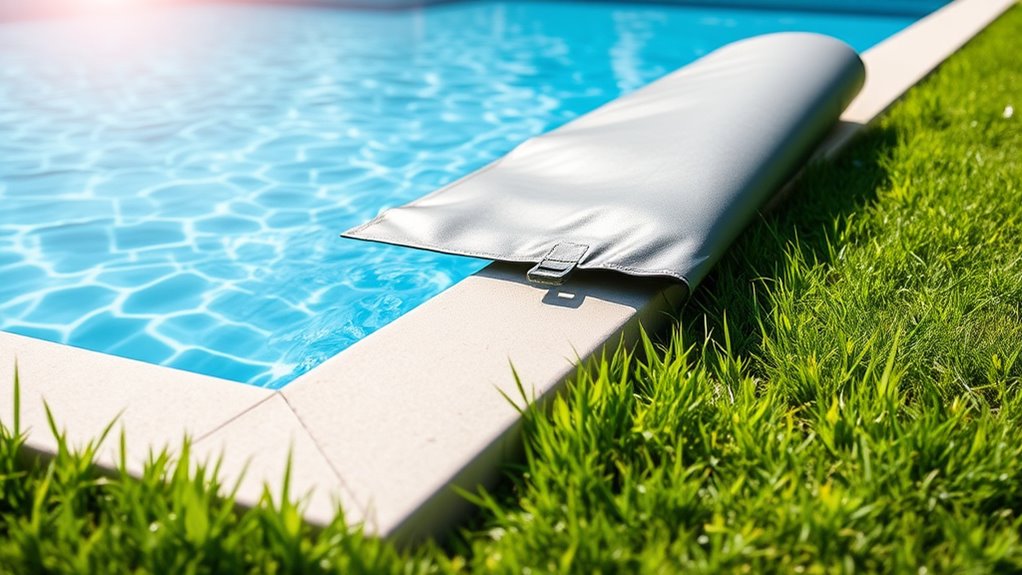
Keeping your pool at the right water level is key to preventing unnecessary water loss. Proper water level management guarantees your pool functions efficiently and avoids wastage from overflows or constant topping. Regularly check the water level, especially after heavy use or rain. Use effective pool topping techniques, like adding water gradually to avoid overshooting the ideal level. Here’s a quick guide:
| Water Level | Topping Technique |
|---|---|
| Below skimmer | Add water slowly using a hose |
| Ideal level | Maintain consistent topping |
| Above skimmer | Remove excess water carefully |
Maintaining the correct level reduces evaporation and prevents strain on your pool’s equipment, saving water and energy in the process. Proper water level management also helps to extend the lifespan of your pool components by reducing unnecessary wear and tear. Stay vigilant, and your pool will stay balanced and efficient. Proper storage of pool water can also prevent water contamination, ensuring the quality and safety of your pool.
Use a Pool Cover When Not in Use
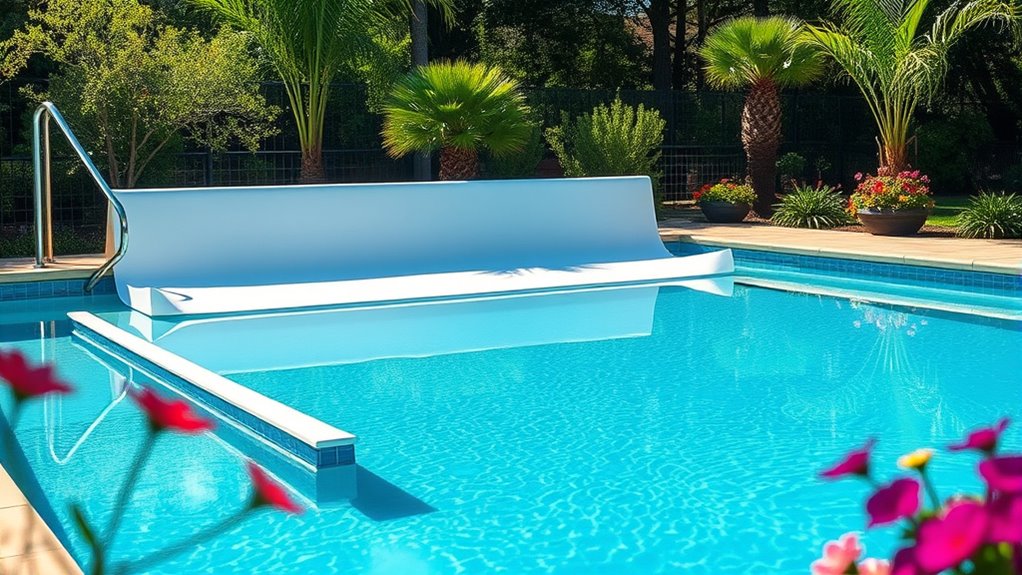
Using a pool cover when your pool isn’t in use helps prevent water from evaporating, saving you from unnecessary refills. It also keeps your pool warmer and reduces the need for extra heating. Plus, it keeps out debris, so you spend less time cleaning. Proper maintenance of your pool equipment, like the use of durable inlet strainers, can further improve water conservation efforts. Incorporating advanced AI technology in pool maintenance systems can also optimize water usage and detect issues early. Developing a consistent creative practice for maintaining your pool can lead to more innovative solutions for water efficiency over time. Additionally, understanding industry trends can help you stay updated on new water-saving techniques and tools.
Prevent Evaporation Loss
Have you ever noticed how much water can evaporate from your pool when it’s left uncovered? Using a pool cover when not in use is a simple way to prevent evaporation loss and conserve water. Pool evaporation can waste thousands of gallons annually, especially in hot or windy weather. A cover traps moisture and reduces this loss considerably. To show how effective it is, here’s a quick comparison:
| Time Without Cover | Water Loss | Water Saved with Cover |
|---|---|---|
| 1 Day | 100 gallons | 80 gallons |
| 1 Week | 700 gallons | 560 gallons |
| 1 Month | 3000 gallons | 2400 gallons |
| 1 Year | 36,500 gallons | 29,200 gallons |
Implementing a pool cover can also support home organization by keeping your pool area tidy and reducing clutter. Additionally, using a cover can help maintain water temperature, reducing the need for energy consumption to heat the pool. Properly covering your pool also minimizes evaporative water loss, which is essential for water conservation efforts. Moreover, advances in smart home devices can help monitor and optimize pool temperatures, further supporting water and energy savings.
Maintain Water Temperature
Ever wonder how much energy it takes to warm your pool every day? Using a pool cover helps retain heat, reducing the need to reheat the water and saving water and energy. When your pool remains covered, it maintains a consistent water temperature, which supports proper water chemistry and pH balance. Fluctuations in temperature can disrupt water chemistry, leading to more frequent chemical adjustments and water waste. By keeping the cover on when the pool isn’t in use, you prevent heat loss caused by evaporation. This not only conserves water but also ensures your pool stays cleaner and easier to maintain. Additionally, fraud detection techniques can help safeguard your financial transactions related to pool maintenance purchases. Implementing proper water testing methods can further optimize your pool’s chemical balance and reduce unnecessary water changes. Maintaining proper water chemistry also prevents the need for frequent water replacement, further conserving water resources. Using a pool cover is an effective method to minimize evaporative water loss, which is one of the primary causes of water waste in pools.
Reduce Debris Contamination
When the pool is not in use, covering it prevents debris such as leaves, dirt, and insects from falling in and contaminating the water. Without a cover, pool debris can quickly accumulate, leading to frequent cleaning and increased water waste. A covered pool keeps out unwanted materials, reducing the risk of water contamination and the need for chemical treatments. This simple step helps maintain cleaner water and minimizes evaporation, saving you water and energy. Additionally, a pool cover protects against dirt settling at the bottom, lowering filtration demands. Proper maintenance routines enhance water quality and help extend the lifespan of your pool equipment and keep your water safe and fresh. Utilizing a self-watering system or similar tools can further optimize water conservation efforts. Understanding zodiac compatibility and practices like covering your pool can contribute to more sustainable and eco-friendly water use. By preventing debris buildup, you extend the lifespan of your pool equipment and keep your water safe and fresh. Using a cover when your pool isn’t in use is an easy, effective way to conserve water and reduce contamination.
Fix Leaks Immediately to Avoid Water Waste
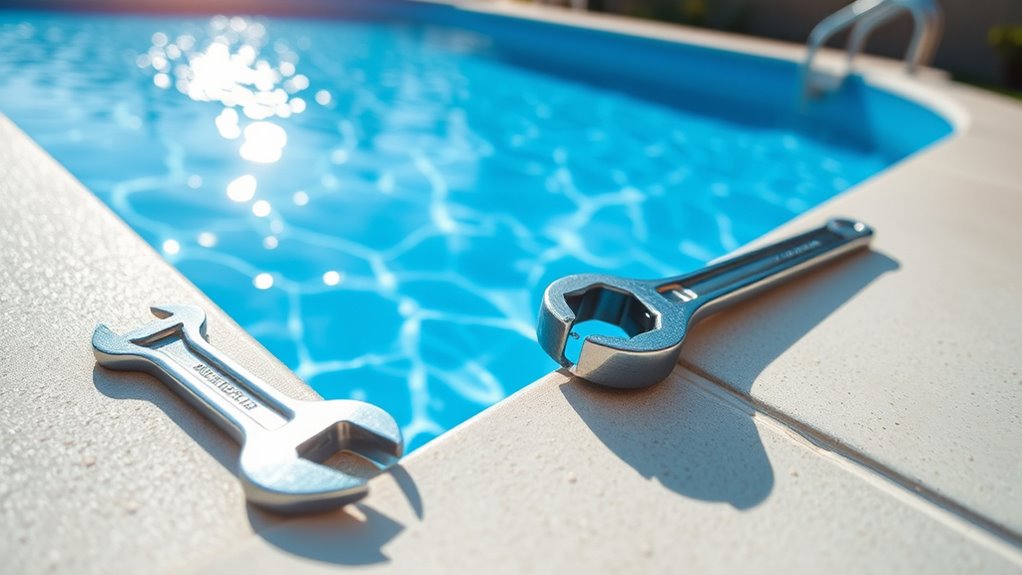
Leaking faucets and pipes may seem minor, but they can waste a surprising amount of water over time. That’s why leak detection is essential—you want to catch leaks early before they turn into bigger problems. When you notice a drip or a drop in your water bill, act quickly to schedule plumbing repairs. Ignoring small leaks can lead to significant water loss, which not only wastes resources but also increases your costs. Regularly inspecting your pool equipment and plumbing connections helps you spot leaks promptly. Addressing these issues fast ensures your pool stays efficient, saving water and money. Automation technologies in pool maintenance, such as leak detectors, can further help identify issues early. Don’t wait for the leak to worsen; fixing leaks immediately is a simple step toward conserving water and maintaining your pool’s health. Incorporating proper maintenance practices can further prevent leaks and ensure your pool operates efficiently. Additionally, understanding wood stove safety standards and regulations helps prevent fire hazards that could result from water-related issues or improper installations around your pool area.
Optimize Filtration and Pump Times for Efficiency
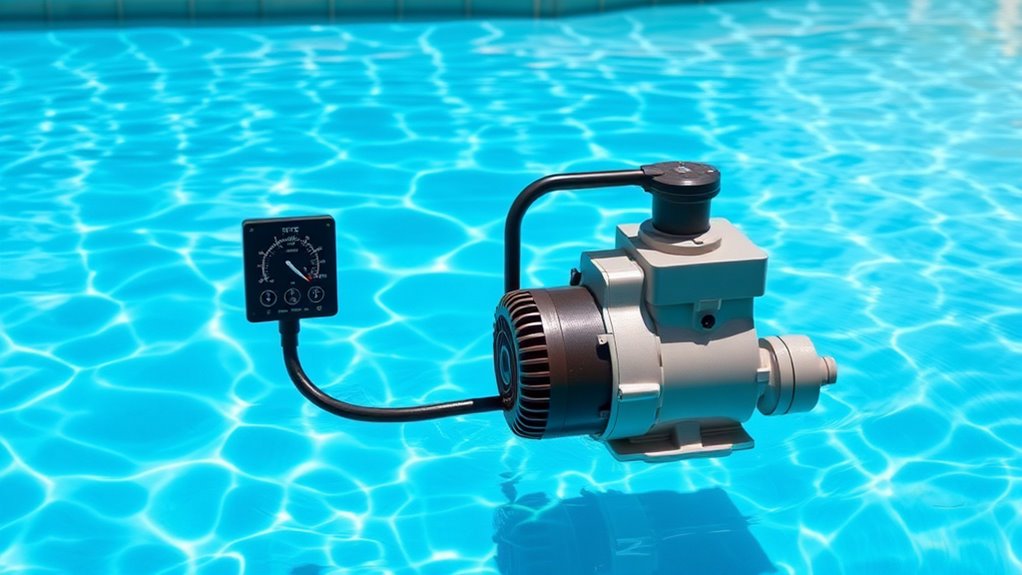
To conserve water, you should adjust your pump run times so it’s not working longer than necessary. Using timer settings effectively can help prevent waste and keep your system running efficiently. Regularly cleaning your filtration system guarantees ideal performance and reduces energy use.
Adjust Pump Run Duration
Adjusting the pump run duration is essential for balancing effective filtration with water and energy conservation. When you set your pump to run too long, you waste energy and increase water evaporation. Conversely, too short a run time can lead to poor water quality. To optimize pump efficiency, evaluate your pool’s needs based on size, usage, and climate. Typically, running the pump 8-12 hours daily is sufficient, but adjusting this based on your specific situation can maximize energy savings. Shortening run times without compromising water clarity reduces power consumption and prolongs equipment life. Regularly monitoring water clarity and chemical levels helps determine the right pump duration. Properly adjusting your pump run time ensures your pool stays clean while conserving water and energy.
Use Timer Settings Effectively
Using timer settings effectively allows you to automate your pool’s filtration schedule, guaranteeing ideal water quality while saving energy. Proper timing adjustments optimize your pump operation, reducing unnecessary water waste and energy use. By setting an automated schedule, you can avoid running the pump longer than needed, especially during off-peak hours. Additionally, adjusting the timer to match seasonal changes ensures efficiency year-round. Here are some tips to maximize your timer’s potential:
- Set shorter run times during cooler months
- Program the pump for early morning hours
- Avoid running the pump during peak electricity periods
- Use seasonal timing adjustments for holidays or vacations
- Regularly review and update your automated scheduling for top performance
Effective use of timer settings helps conserve water and reduces your energy costs.
Regularly Clean Filtration System
Have you ever wondered how a clean filtration system can boost your pool’s efficiency? Regularly cleaning your filtration system ensures it runs smoothly, reducing energy use and water waste. Over time, debris and dirt clog filters, making the pump work harder and consuming more water. Incorporate routine cleaning routines, like backwashing and replacing filter media, to keep your system operating at its best. When your filtration system is clean, it filters water more effectively, maintaining clear water with less effort. This not only conserves water but also extends the lifespan of your equipment. Consistent maintenance minimizes unnecessary pump run times, saving both water and energy. Staying on top of your filtration system’s cleaning routines is a simple, effective way to reduce pool water waste while keeping your pool pristine.
Choose Water-Conserving Pool Equipment

Choosing water-conserving pool equipment is one of the most effective ways to reduce water waste. Upgrading to energy-efficient pumps, solar heating, and saltwater systems can considerably cut water use and costs. These systems minimize evaporation and optimize water circulation, reducing the need for frequent refills. When selecting equipment, consider options like:
Opt for water-saving pool equipment like solar heaters, saltwater systems, and energy-efficient pumps to reduce waste and costs.
- Solar pool heaters for eco-friendly heating
- Saltwater chlorination systems for lower chemical use
- Variable-speed pumps for efficient circulation
- Pool covers to prevent evaporation
- Automated controllers to manage filtration times
Implement Smart Water Management Practices
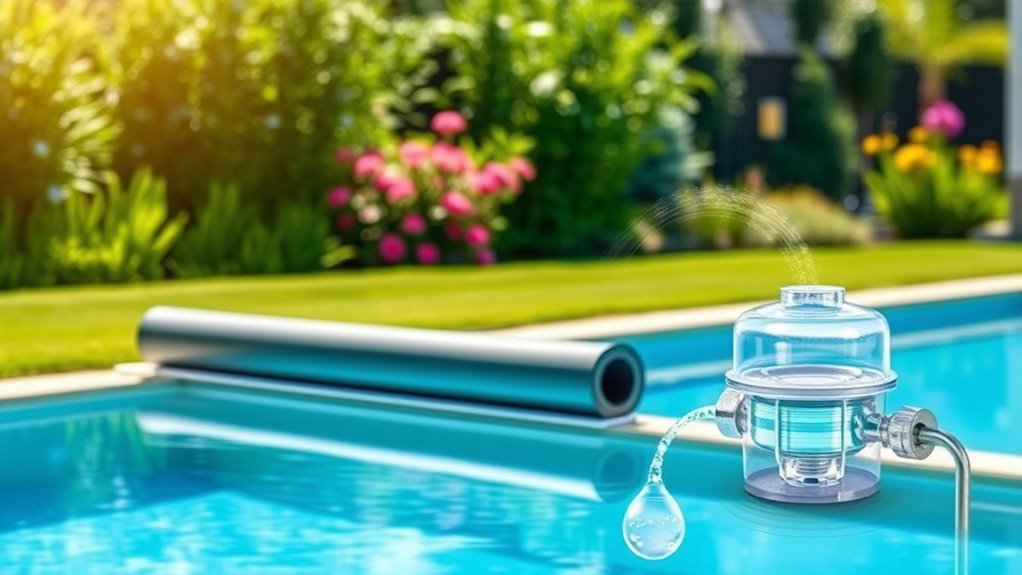
Implementing smart water management practices is essential for maintaining an efficient and eco-friendly pool. Using smart water meters, you can monitor your water usage in real-time, helping you identify leaks and unnecessary waste. These devices provide accurate data, enabling you to make informed decisions to conserve water. Additionally, rainwater harvesting allows you to collect and store rainwater for pool top-ups, reducing reliance on tap water and lowering your water bills. By integrating these practices, you optimize your pool’s water use, minimize waste, and contribute to environmental sustainability. Smart water management isn’t just about saving water; it’s about creating a responsible, efficient pool environment that benefits both your wallet and the planet.
Schedule Regular Maintenance and Inspections
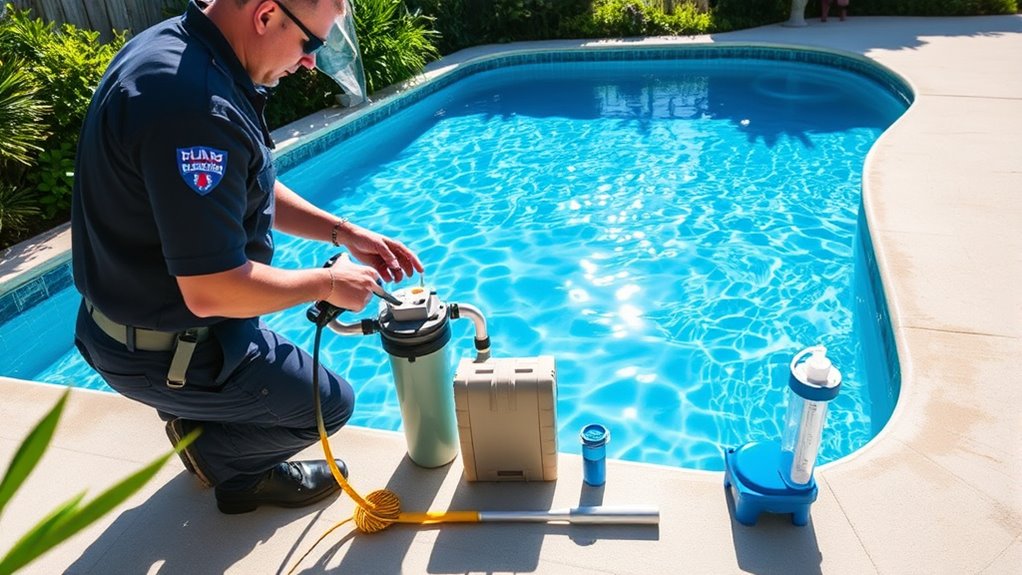
Regularly scheduling maintenance and inspections is essential for keeping your pool running efficiently and preventing costly repairs. Proper upkeep ensures water stays clean, balanced, and safe. During inspections, focus on pool chemical balancing to avoid overuse or waste of water. Use water testing techniques to monitor pH, chlorine levels, and alkalinity regularly. This helps maintain the right chemical balance, reducing the need for frequent refills. Additionally, check the pool pump, filter, and skimmer for clogs or leaks to prevent water loss. Keep an eye on the pool liner for damage and ensure all equipment functions properly. Regular maintenance not only conserves water but also extends your pool’s lifespan.
- Test water regularly using proper water testing techniques
- Adjust pool chemicals for ideal chemical balancing
- Inspect pool equipment for leaks or malfunctions
- Clean filters and skimmers to maintain efficiency
- Address repairs promptly to prevent water waste
Educate Household Members on Water Conservation Strategies
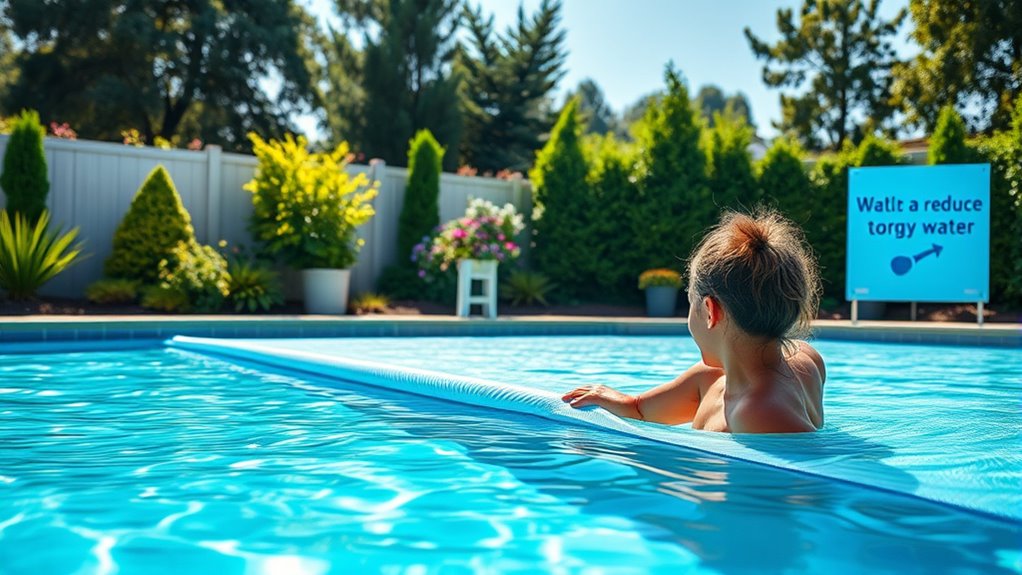
Educating household members on water conservation strategies is essential for reducing overall water usage. When everyone understands the importance of household water awareness, they can contribute to conserving water daily. Involving your conservation team—family members or roommates—ensures shared responsibility and better results. Visualize the impact with this table:
| Household Member | Water-Saving Action |
|---|---|
| Parent | Fix leaks immediately |
| Teenager | Shorten shower time |
| Child | Turn off taps properly |
Frequently Asked Questions
How Can I Tell if My Pool Has a Leak?
If you suspect a leak, start with simple pool maintenance checks. Conduct a water test by noting the water level over several days without using the pool. If the level drops considerably, you likely have a leak. You can also perform a dye test near the pool’s edges to pinpoint the leak source. Regular water testing and vigilant monitoring help prevent water waste and keep your pool in good condition.
What Is the Ideal Water Level for My Pool?
You want to keep your pool’s water level ideal for proper water balancing and to prevent unnecessary water evaporation. Check the skimmer opening—if water is below the skimmer, add water until it reaches the correct level. This balance helps slow water evaporation, ensures your pool’s filtration works efficiently, and keeps your pool clean. Regularly monitoring and maintaining this level saves water and keeps your pool in perfect condition.
How Often Should I Check for Pool Leaks?
You should check for pool leaks regularly, ideally once a week, especially during hot weather when evaporation increases. Keep an eye on the water level and look for signs of water loss beyond normal evaporation. Use leak prevention techniques like inspecting hoses, fittings, and the pool’s structure. Promptly addressing leaks helps conserve water, prevents damage, and guarantees your pool stays balanced and safe for swimming.
Are There Eco-Friendly Pool Covers Available?
Yes, eco-friendly pool covers are available. You can opt for solar covers made from biodegradable materials, which help retain heat and reduce evaporation while being environmentally friendly. These covers are designed to be durable yet eco-conscious, so you can protect your pool and conserve water without harming the planet. Check with suppliers for options that prioritize sustainability, and you’ll find a practical way to make your pool more eco-friendly.
What Signs Indicate My Pool Equipment Needs Replacement?
You’ll notice signs your pool equipment needs replacement when you struggle to maintain proper pool chemical balance, despite following pool cleaning tips. If your filter constantly runs or doesn’t clear debris, it’s a red flag. Leaking pumps or inconsistent circulation indicate worn-out parts. Address these issues promptly to avoid costly repairs and keep your pool clean and inviting. Regular maintenance helps spot these signs early and guarantees your equipment functions efficiently.
Conclusion
By taking these simple steps, you become the guardian of your pool’s precious water, turning it into a fortress against waste. Cover it like a shield in battle, fix leaks like patching leaks in a sinking ship, and manage your equipment like a skilled conductor. Every small effort you make is a drop in the ocean of conservation. Together, you can keep your pool sparkling and the planet thriving—one splash at a time.




